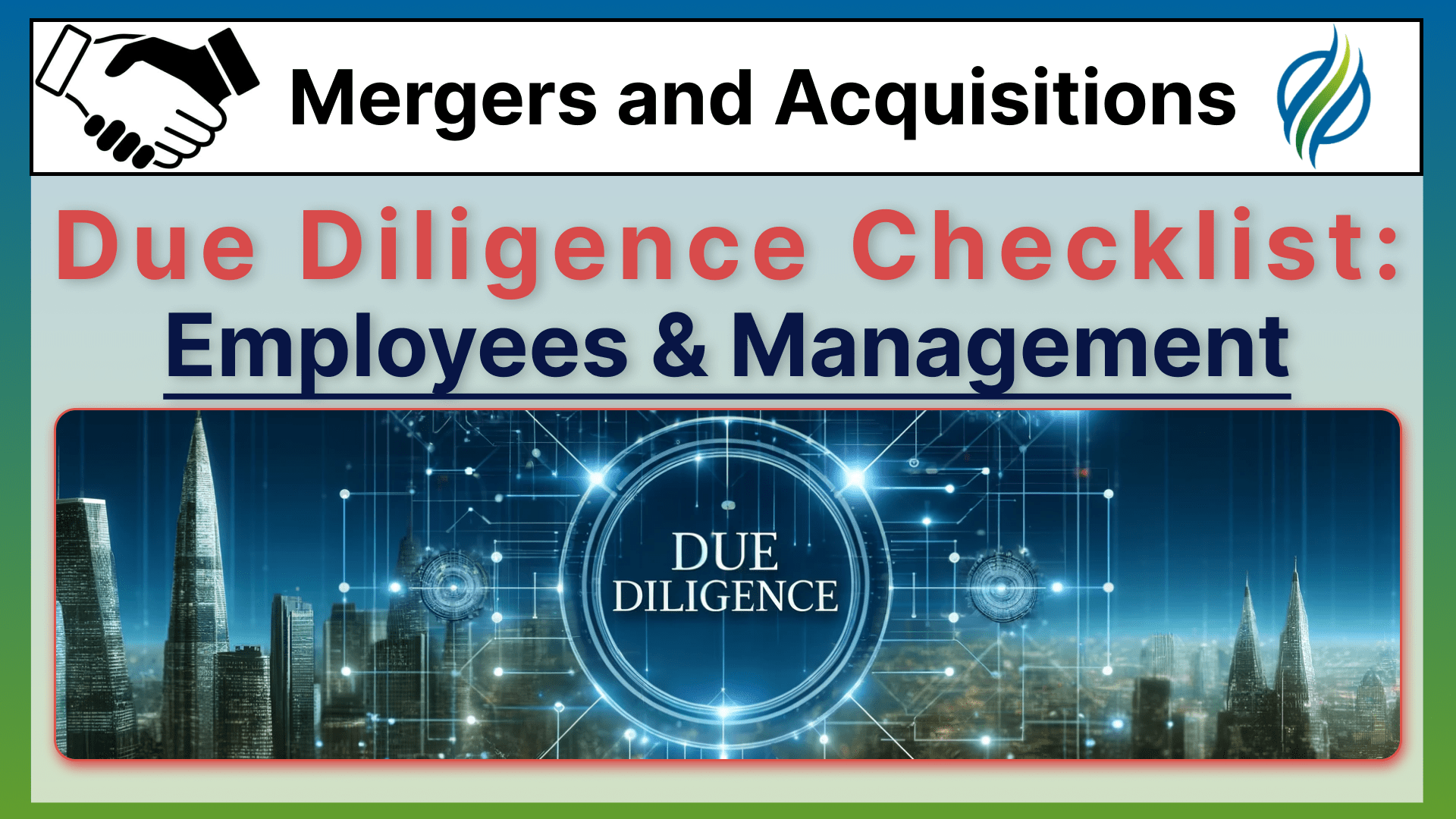In mergers and acquisitions, understanding the quality of a company’s employees and management is crucial.
This article explores key areas to review, including management qualifications, labor relations, employee satisfaction, benefits, and compliance with employment laws.
By focusing on these aspects, you can make informed decisions and reduce risks.
 Key Takeaways
Key Takeaways
- Assess the management team's qualifications, experience, and performance to ensure strong leadership.
- Review labor relations and disputes to identify potential risks and ensure stability.
- Evaluate employee satisfaction and turnover rates to understand the workforce's overall health.
- Examine employee benefits and compensation plans to identify liabilities and ensure competitiveness.
- Ensure compliance with employment laws to avoid legal risks and liabilities.
This guide explains the importance of each section in detail.
You’ll learn practical steps to assess each area effectively.
Self-assessment questions help you stay on track.
Use the provided resources for deeper insights.
 Table of Contents
Table of Contents
To get the most out of this article, follow each section closely.
Apply the steps to your due diligence process.
This approach ensures a thorough evaluation of the target company’s workforce.
Keep reading to master the essentials of M&A due diligence for employees and management.
Your successful acquisition starts here…

➤ MORE: Check out the FULL Due Diligence Checklist here
Review Management Organization Chart and Biographies:
A critical part of due diligence is obtaining the management organization chart and biographies of key executives.
This process involves a thorough review of their qualifications, experience, and performance history.
Understanding the leadership team’s strengths and identifying any gaps is crucial for assessing the target company’s future potential.
Practical Benefits:
-
Identifies strengths and weaknesses in leadership.
-
Provides insights into the stability and experience of the management team.
-
Helps predict future performance and integration success.
Importance:
-
Leadership quality directly affects company performance and integration post-acquisition.
-
Identifying gaps early allows for strategic planning and intervention.
Practical Steps:
-
Obtain Documents: Request the organizational chart and detailed biographies of key executives from the target company.
-
Review Qualifications: Examine the educational and professional background of each executive to ensure they possess the necessary skills and experience.
-
Assess Performance: Analyze past performance reviews, accomplishments, and any notable achievements or failures.
-
Identify Gaps: Look for any missing competencies or weaknesses within the team and consider how these might impact the company post-acquisition.
-
Interview Key Executives: Conduct interviews to gain deeper insights into their leadership style, strategic vision, and alignment with your company’s goals.
Self-Assessment Questions:
-
Who are the key members of the management team, and what are their backgrounds?
-
How experienced and qualified are these individuals?
-
Are there any gaps or weaknesses in the management team?
-
How effective is the management team in achieving business goals?
Resources:
Assess Labor Relations and Disputes:
Understanding labor relations and any disputes is vital in assessing potential risks.
Reviewing past and current labor disputes, including any pending or threatened labor stoppages, helps you gauge the company’s labor environment and predict future challenges.
Practical Benefits:
-
Identifies potential risks and liabilities.
-
Provides a clear picture of the company’s labor relations environment.
-
Helps in planning for future labor negotiations or disputes.
Importance:
-
Labor disputes can significantly disrupt operations and affect profitability.
-
Good labor relations are indicative of a stable and productive work environment.
Practical Steps:
-
Collect Information: Gather all records of past and current labor disputes, including grievances and resolutions.
-
Analyze Trends: Look for patterns in the disputes to identify recurring issues or common points of contention.
-
Evaluate Impact: Assess how past disputes have impacted operations, productivity, and financial performance.
-
Consult Legal Advisors: Work with legal advisors to understand the potential implications of ongoing or unresolved disputes.
-
Plan for Mitigation: Develop strategies to address and mitigate potential future labor issues.
Self-Assessment Questions:
-
Are there any ongoing or past labor disputes?
-
What are the main issues raised by employees or unions?
-
How has the company handled labor disputes in the past?
-
What is the current relationship between management and employees?
Resources:
Assess Employee Satisfaction and Turnover:
Evaluating employee satisfaction and turnover rates provides insights into the overall health of the company’s workforce.
High satisfaction and low turnover indicate a positive work environment, while the opposite may signal underlying issues.
Practical Benefits:
-
Identifies areas of employee dissatisfaction.
-
Helps predict future turnover and its impact on operations.
-
Provides a basis for improving HR policies and practices.
Importance:
-
Employee satisfaction directly impacts productivity and company culture.
-
High turnover can be costly and disruptive to operations.
Practical Steps:
-
Survey Employees: Conduct anonymous surveys to gauge employee satisfaction levels and gather feedback on various aspects of the work environment.
-
Analyze Turnover Data: Review turnover statistics to identify trends and patterns, such as high turnover in specific departments or roles.
-
Identify Causes: Investigate the main reasons for turnover by conducting exit interviews and analyzing survey responses.
-
Implement Improvements: Based on findings, develop and implement strategies to improve employee satisfaction and reduce turnover, such as enhancing benefits, increasing engagement, and addressing specific concerns.
Self-Assessment Questions:
-
What are the current employee satisfaction levels?
-
What is the company’s employee turnover rate?
-
What are the main reasons for employee turnover?
Resources:
Examine Employee Benefits and Compensation Plans:
Obtaining and reviewing summaries of employee benefits and compensation plans is essential.
This includes pension, profit-sharing, and retirement plans.
Ensuring these plans are competitive and identifying any potential liabilities is crucial for financial stability and employee retention.
Practical Benefits:
-
Identifies potential financial liabilities.
-
Ensures competitive compensation structures.
-
Enhances employee retention and satisfaction.
Importance:
-
Competitive benefits are critical for attracting and retaining talent.
-
Potential liabilities in benefits plans can impact financial stability.
Practical Steps:
-
Collect Summaries: Request detailed summaries of all employee benefits and compensation plans from the target company.
-
Compare Industry Standards: Benchmark the company’s benefits against industry standards to ensure competitiveness.
-
Identify Liabilities: Review financial reports to identify any unfunded liabilities, especially in pension or retirement plans.
-
Assess Terms: Examine the terms of benefits agreements for any unusual or non-standard clauses that could pose risks.
-
Consult Financial Advisors: Work with financial advisors to understand the long-term implications of the benefits plans.
Self-Assessment Questions:
-
What employee benefits and compensation plans are in place?
-
How competitive are these benefits compared to industry standards?
-
Are there any unfunded liabilities related to pension or retirement plans?
-
Are there any unusual or non-standard terms in these agreements?
-
What are the key components of the company’s compensation structure?
Resources:
Evaluate Key Employee Retention Plans:
Reviewing retention or incentive plans for key employees is crucial.
These plans ensure that essential talent remains with the company post-acquisition, which is vital for continuity and achieving strategic goals.
Practical Benefits:
-
Ensures continuity of critical operations.
-
Retains essential talent and reduces turnover risk.
-
Enhances overall acquisition success.
Importance:
-
Retention of key employees is crucial for operational stability.
-
Incentive plans can drive performance and alignment with company goals.
Practical Steps:
-
Identify Key Employees: Determine which employees are critical to the company’s success and must be retained.
-
Review Retention Plans: Examine existing retention and incentive plans to assess their effectiveness and coverage.
-
Assess Plan Effectiveness: Evaluate the historical effectiveness of these plans in retaining key talent.
-
Develop New Strategies: If necessary, develop new or enhanced retention strategies to ensure key employees stay post-acquisition.
-
Communicate Clearly: Ensure clear communication with key employees about their value to the company and the benefits of the retention plans.
Self-Assessment Questions:
-
Who are the key people that need to be retained post-acquisition?
-
What retention or incentive plans are in place for key employees?
-
How effective are these plans in retaining critical talent?
-
Are there any gaps in the retention strategy?
-
Are there any cultural or operational challenges in retaining these individuals?
-
How critical are these individuals to the success of the acquisition?
Resources:
Analyze Compliance with Employment Laws:
Verifying the company’s compliance with employment laws and regulations is fundamental.
Identifying potential legal risks ensures that the company is not exposed to liabilities related to non-compliance, which could have significant financial and reputational consequences.
Practical Benefits:
-
Identifies potential legal risks and liabilities.
-
Ensures compliance with relevant regulations.
-
Protects the company from legal actions and fines.
Importance:
-
Compliance is crucial to avoid legal penalties.
-
Ensures smooth integration and continuity post-acquisition.
Practical Steps:
-
Review Legal Documents: Gather and review all documents related to employment laws and regulations compliance.
-
Conduct Audits: Perform internal audits to identify any areas of non-compliance or potential risks.
-
Consult Legal Experts: Work with employment law experts to understand the implications of any compliance issues.
-
Develop Action Plans: Create action plans to address and resolve any identified compliance issues.
-
Monitor Continuously: Establish ongoing monitoring processes to ensure continued compliance with employment laws.
Self-Assessment Questions:
-
Is the company in compliance with all relevant employment laws and regulations?
-
Are there any ongoing investigations or legal actions related to employment issues?
-
How does the company handle compliance with labor laws?
-
Are there any potential liabilities related to non-compliance?
Resources:
FAQs - Frequently Asked Questions About Due Diligence into a Company’s Employees and Management Techniques

Why is evaluating the management team important in M&A due diligence?
It ensures strong leadership and identifies gaps.
Leadership quality directly impacts company performance.
Learn More...
Evaluating the management team provides insights into their qualifications, experience, and performance.
Strong leadership is crucial for guiding the company through the acquisition and ensuring successful integration.
Identifying gaps early allows for strategic planning and targeted interventions to address weaknesses.
Leadership quality directly influences company culture, employee morale, and overall business success.
How do labor relations impact a company's stability during M&A?
Poor labor relations can disrupt operations and affect profitability.
Good labor relations indicate a stable work environment.
Learn More...
Labor relations impact a company's operational stability, productivity, and financial performance.
Past and current labor disputes can signal potential risks that might arise post-acquisition.
Positive labor relations suggest a cooperative and productive work environment, reducing the risk of disruptions.
Understanding labor relations helps in planning for future negotiations and addressing employee concerns.
What role does employee satisfaction play in M&A success?
High satisfaction boosts productivity and reduces turnover.
Low satisfaction can signal underlying issues.
Learn More...
Employee satisfaction directly affects productivity, morale, and retention rates.
High satisfaction levels suggest a healthy work environment, which is crucial for smooth integration post-acquisition.
Low satisfaction may indicate underlying HR issues that need to be addressed to prevent disruptions.
Evaluating satisfaction helps identify areas for improvement and ensures a positive transition for employees.
Why is it important to review employee benefits and compensation plans?
To identify liabilities and ensure competitiveness.
Benefits impact employee retention and satisfaction.
Learn More...
Reviewing benefits and compensation plans helps identify potential financial liabilities, such as unfunded pension plans.
Competitive benefits are essential for attracting and retaining top talent, crucial during and after an acquisition.
Understanding the compensation structure ensures that it aligns with industry standards and supports employee retention.
This review also highlights any unusual terms that might pose risks or require adjustments post-acquisition.
How does compliance with employment laws affect M&A deals?
Non-compliance can lead to legal risks and fines.
Ensures smooth integration and continuity.
Learn More...
Compliance with employment laws is crucial to avoid legal penalties and ensure smooth operations post-acquisition.
Non-compliance can result in fines, legal actions, and reputational damage, impacting the overall success of the M&A deal.
Verifying compliance involves reviewing legal documents, conducting audits, and consulting with legal experts.
Addressing any compliance issues early ensures that the company is legally protected and ready for a successful transition.
What are the key components of a successful employee retention plan?
Identify critical talent and create effective incentive plans.
Ensure clear communication and alignment with company goals.
Learn More...
A successful retention plan identifies key employees crucial for the company's success and creates tailored incentive plans.
These plans should include financial incentives, career development opportunities, and clear communication of their value to the company.
Ensuring alignment between the retention strategies and company goals helps in maintaining morale and productivity post-acquisition.
Regularly reviewing and adjusting these plans ensures they remain effective and relevant to the employees' needs.
How can analyzing turnover rates benefit the M&A process?
It helps understand workforce stability.
Identifies potential HR issues.
Learn More...
Analyzing turnover rates provides insights into workforce stability and potential HR issues within the company.
High turnover rates may indicate dissatisfaction, poor management, or other underlying problems that need to be addressed.
Understanding turnover trends helps in developing strategies to improve retention and ensure a smooth integration process.
Addressing turnover issues early can enhance employee morale and productivity, contributing to the overall success of the acquisition.
In Summary…
In mergers and acquisitions, thorough due diligence on employees and management is critical.
This article has outlined the essential steps to assess the management team, review labor relations, evaluate employee satisfaction, examine benefits and compensation plans, and ensure compliance with employment laws.
By following these guidelines, you can make informed decisions, mitigate risks, and facilitate a smoother integration post-acquisition.
Applying this information in a practical sense involves conducting detailed reviews, performing necessary audits, and developing strategies to address identified issues.
Entrepreneurs who utilize these steps will gain a comprehensive understanding of the target company’s workforce, ensuring that potential challenges are identified and managed effectively.
This not only enhances the likelihood of a successful acquisition but also supports the long-term stability and growth of the merged entity.
Ready to take the next step in your M&A journey?
Schedule a consultation call with Business Initiative today or use our contact form to get started.
Stay informed by subscribing to our newsletter for the latest insights and updates.
For more resources and updates, check out our Initiative Newsletter and follow us on X.
Your successful acquisition begins with the right due diligence.
Sources
- LinkedIn: For researching management team qualifications and biographies.
- Glassdoor: For employee reviews and insights on company culture and management.
- HireRight: For conducting background checks and verifying management team credentials.
- National Labor Relations Board (NLRB): For information on labor disputes and labor relations.
- SHRM: For resources on labor relations and human resources management.
- The Balance Careers: For exit interview guides and employee retention strategies.
- SurveyMonkey: For conducting employee satisfaction surveys.
- Visier: For HR analytics tools to analyze employee data.
- Bloomberg: For financial information and industry analysis.
- U.S. Department of Labor: For information on employment laws and regulations.
- Mercer: For retention consultants and employee compensation benchmarking.
- PayScale: For benchmarking compensation plans against industry standards.


